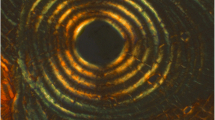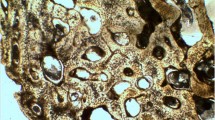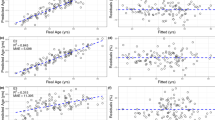Abstract
Determinations of chronologic age are of great importance in forensic science. At present the aspartic acid racemization method on teeth provides one of the best means in adult individuals. However, if teeth are not available, some other stable tissue has to be used. In this study, the applicability of cartilage from the ribs has been tested. Specimens of rib cartilage were obtained at autopsy from 24 individuals aged 0.2–96 years. An acid-soluble peptide (SP) fraction and an insoluble collagen-rich (IC) fraction were prepared, and the ratio of D/L aspartic acid was determined using the HPLC technique. The correlation coefficient between the D/L ratio and age was r = 0.91 in SP and r = 0.97 in IC. It thus seems as if cartilage from non-weight-bearing areas may be a useful source of tissue for the estimation of chronologic age with the aspartic acid racemization method when teeth are not available.
Similar content being viewed by others
References
Helfman PM, Bada JL (1975) Aspartic acid racemization in tooth enamel from living humans. Proc Natl Acad Sci USA 72: 2891–2894
Helfman PM, Bada JL (1976) Aspartic acid racemization in dentine as a measure of ageing. Nature 262:279–281
Ogino T, Ogino H, Nagy B (1985) Application of aspartic acid racemization to forensic odontology: post mortem designation of age at death. Forensic Sci Int 29:259–267
Masters PM (1986) Age at death determinations for autopsied remains based on aspartic acid racemization in tooth dentine: importance of postmortem conditions. Forensic Sci Int 32: 179–184
Ogino T, Ogino H (1988) Application to forensic odontology of aspartic acid racemization in unerupted and supernumerary teeth. J Dent Res 67: 1319–1322
Ohtani S, Kato S, Sugeno H, Sugimoto H, Marumo T, Yamazaki M, Yamamoto K (1988) A study on the use of the amino-acid racemization method to estimate the ages of unidentified cadavers from their teeth. Bull Kanagawa Dent Coll 16:11–21
Ohtani S, Sugeno H, Marumo T, Yamamoto K (1989) Two cases of age estimation from teeth of burned body using amino acid racemization. Nippon Hoigaku Zasshi 43:191–197
Ohtani S, Yamamoto K (1987) Age estimation using the racemization of aspartic acid on human dentine. Nippon Hoigaku Zasshi 41:181–190
Ohtani S, Yamamoto K (1990) Estimating age through the amino acid racemization of acid-soluble dentinal peptides. Nippon Hoigaku Zasshi 44:342–345
Ohtani S, Yamamoto K (1990) Racemization velocity of aspartic acid in dentine. Nippon Hoigaku Zasshi 44:346–351
Ohtani S, Yamamoto K (1991) Age estimation using the racemization of amino acid in human dentine. J Forensic Sci 36:792–800
Ohtani S, Yamamoto K (1991) Age estimation by amino acid racemization in teeth — a comparison of aspartic acid with glutamic acid and alanine as indicators. Nippon Hoigaku Zasshi 45:119–123
Ohtani S, Yamamoto K (1991) Estimation of ages from racemization of an amino acid in teeth — assessment of errors under various experimental conditions. Nippon Hoigaku Zasshi 45: 124–127
Ohtani S, Yamamoto K (1992) Estimation of age from a tooth by means of racemization of an amino acid, especially aspartic acid — comparison of enamel and dentine. J Forensic Sci 37: 1061–1067
Ritz S, Schütz HW, Schwarzer B (1990) The extent of aspartic acid racemization in dentine: a possible method for a more accurate determination of age at death? Z Rechtsmed 103: 457–462
Ritz S, Schütz HW, Peper C (1993) Postmortem estimation of age at death based on the aspartic acid racemization in dentin: its applicability for root dentin. Int J Legal Med 105:289–293
Mörnstad H, Pfeiffer H, Teivens A (1994) Estimation of dental age using HPLC-technique to determine the degree of aspartic acid racemization. J Forensic Sci 39:1425–1471
Man EH, Sandhouse ME, Burg J, Fisher GH (1983) Accumulation of D-aspartic acid with age in the human brain. Science 220:1407–1408
Masters PM, Bada JL, Zigler JS Jr (1977) Aspartic acid racemization in the human lens during ageing and in cataract formation. Science 268:71–73
Shapiro SD, Endicott SK, Provance MA, Pierce JA, Campell EJ (1991) Marked longevity of human lung parenchymal elastic fibres deduced from prevalence of D-aspartate and nuclear weapons-related radiocarbon. J Clin Invest 87:1828–1834
Ritz S, Turzynski A, Martz W, Schdtz HW (1992) In-vivoRazemisierung von Asparaginsdure in nicht-kollagenen Knochenpeptiden und Lebensaltersbestimmung an der Leiche. Zbl Rechtsmed 38:19
Turzynski A, Ritz S (1994) Demonstration of the marked longevity and low turnover of osteocalcin in bone. Exp Clin Endocrinol 102 [Suppl 1]:104
Maroudas A (1980) Metabolism of cartilaginous tissues: a quantitative approach. In: Maroudas A, Holborow EJ (eds) Studies in joint diseases. Pitman Medical, London, pp 59–66
Lippiello L, Munkin HJ (1976) Collagen turnover in osteoarthritis. Trans Orthop Res Soc 1:94–98
Maroudas A, Palla G, Gilav E (1992) Racemization of aspartic acid in human articular cartilage. Connect Tissue Res 28: 161–169
Ritz S, Schutz HW (1993) Aspartic acid racemization in intervertebral discs as an aid to postmortem estimation of age at death. J Forensic Sci 38:633–640
Aswad DW (1984) Determination ofd- andl-aspartate in amino acid mixtures by high-performance liquid chromatography after derivatization with a chiral adduct of ophthaldialdehyde. Anal Biochem 137: 405–1109
Pfeiffer H, Mömstad H, Teivens A (1995) Estimation of chronologic age using the aspartic acid racemization method. II. On human cortical bone. Int J Legal Med
Author information
Authors and Affiliations
Additional information
This study was supported by grant # B93-241-10277-01 from the Swedish Medical Research Council and Deutscher Akademischer Austauschdienst grant # 517 023 502 3
Rights and permissions
About this article
Cite this article
Pfeiffer, H., Mörnstad, H. & Teivens, A. Estimation of chronologic age using the aspartic acid racemization method. I. On human rib cartilage. Int J Leg Med 108, 19–23 (1995). https://doi.org/10.1007/BF01845611
Received:
Revised:
Issue Date:
DOI: https://doi.org/10.1007/BF01845611




